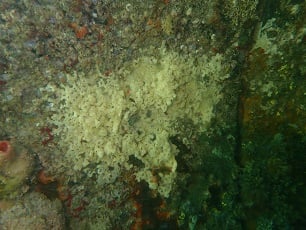
Carpet sea squirt
Carpet sea squirt is an invasive marine pest primarily spread by the movement of vessels and marine equipment. It can overgrow rocks, shellfish, sea sponges and man-made structures such as wharves, jetty pylons, pontoons, buoys and commercial and recreational vessels.

Carpet sea squirt (CSS) has been detected in two WA locations: at HMAS Stirling Garden Island, and the Australian Marine Complex (AMC), Henderson. CSS is also present at Fleet Base East (FBE) in Sydney, New South Wales.
It is native to east Asia and has been introduced to New Zealand, North America and Europe.
It is primarily spread by the movement of vessels and marine equipment with carpet sea squirt biofouling. It can overgrow rocks, shellfish, sea sponges and man-made structures such as wharves, jetty pylons, pontoons, buoys and commercial and recreational vessels.
It is a noxious fish listed under the Fish Resources Management Act 1994 and a declared pest under the Biosecurity and Agriculture Management Act 2007.
What can I do to prevent CSS from spreading in WA?
Vessels operating in areas of risk can minimise the spread of CSS through vessel biofouling management actions such as maintaining the antifouling coat of the vessel and having a vessel biofouling management plan and record book. Recreational boaters, fishers and divers can assist in stopping the spread of marine pests and aquatic disease by keeping their boats, trailers, wetsuits and equipment clean.
Clean all equipment with soapy water and allow to dry completely before using them at another location, even if it is on the same day. When cleaning, make sure any bait, debris and seaweed is removed and not returned to the water. Check wheel arches on trailers, boat propellors, fishing tackle and footwear. Do not clean in the water or allow run off to enter the ocean.
There are many native species that look like carpet sea squirt so expert taxonomic identification and molecular techniques are required to confirm the identity of the species.
What is the current situation?
Throughout the past 2 years, DPIRD worked with the Australian Government Department of Defence, the Department of Agriculture, Fisheries and Forestry, Fremantle Port Authority and local stakeholders to respond to the detection of CSS.
The CSS response has now transitioned to management after a 12-month transition to management phase following the determination at the national level that it was not feasible to eradicate CSS from Australia.
The Quarantine Area Notice issued on 15 March 2024 for the Australian Marine Complex Common User Facility (AMC CUF) and BAE Systems Australia Pty Ltd is no longer in place, however, CSS remains a noxious fish under the Fish Resources Management Act 1994 (FRMA) and a declared pest under the Biosecurity and Agriculture Management Act 2007 (BAM Act).
During the emergency response phase of the CSS incident, CSS was assigned a control category of C1 – Exclusion for the whole of the state except for the area surrounding the known incursion sites within Cockburn Sound. The control category for the Cockburn Sound area has been amended to C3 – Management. More information and a map are available below.
Report unusual species
If you find unusual marine species attached to vessels, sub-merged infrastructure or in the marine environment, please report it to DPIRD's aquatic biosecurity team.
Report an aquatic pest-
CSS management guidelinespdf (489 KB)
-
CSS C3 area - Cockburn Soundpdf (812 KB)
Learn more
-
Carpet sea squirt factsheetpdf (2 MB)
-
Carpet sea squirt frequently asked questionspdf (224 KB)
Contact Us
-
Aquatic Pest Biosecurity

